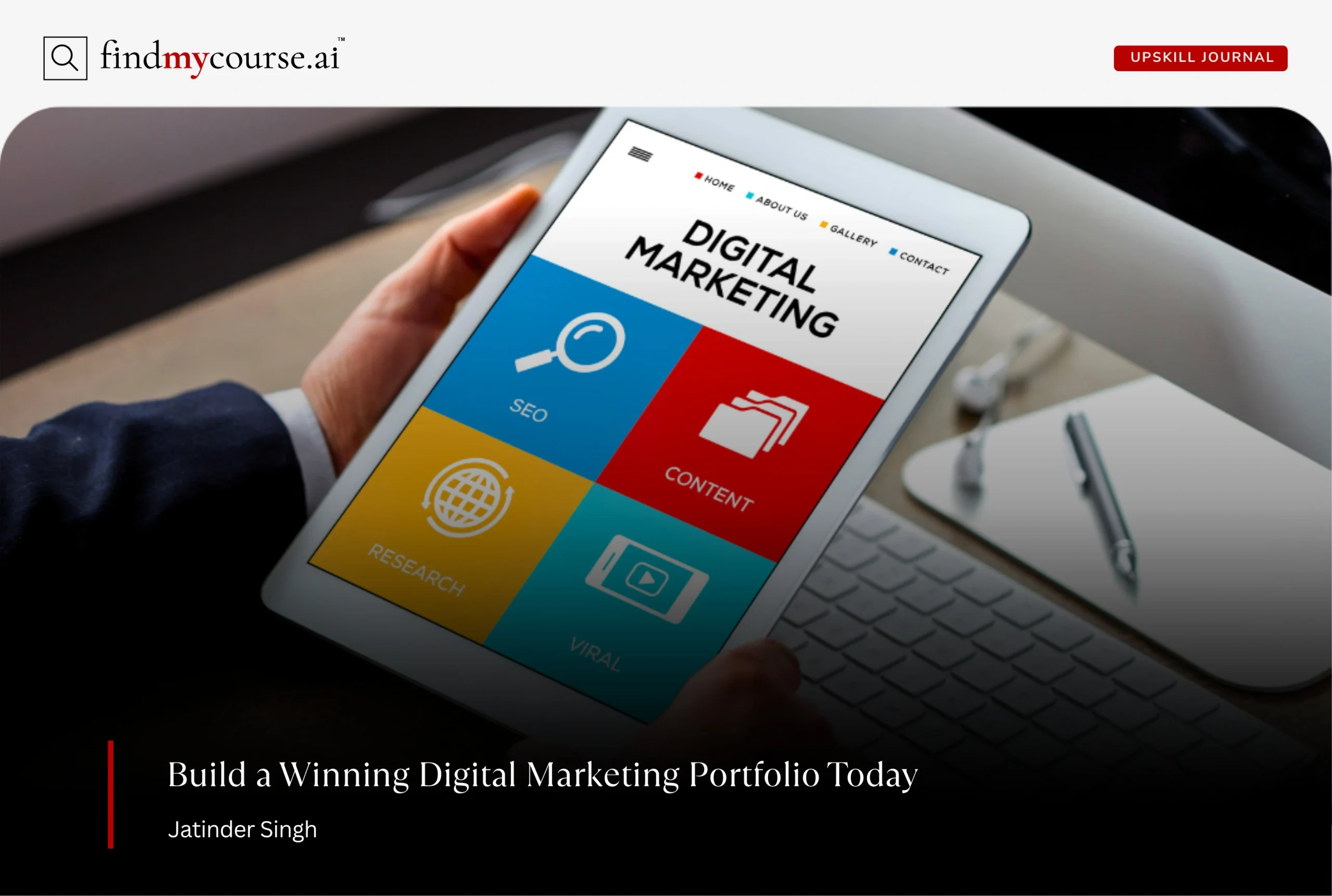In today’s digital landscape, every click, like, and share counts, and digital marketers aren’t just producing content—they’re shaping experiences and driving measurable results. To stand out, it’s not enough to master the tools; you need to demonstrate real impact. A digital marketing portfolio does just that. Beyond showcasing projects, it tells the story of your creativity, strategic thinking, and professional growth. Whether you’re attracting clients, aiming for a promotion, or impressing employers, a well-crafted portfolio highlights achievements and reflects your commitment to upskilling. This guide will walk you through building a portfolio that truly showcases your capabilities.
Why You Need a Digital Marketing Portfolio
A digital marketing portfolio is your professional narrative in action. Unlike a resume that lists your qualifications, a portfolio visually and strategically presents your accomplishments. It shows employers and clients what you can achieve, how you approach challenges, and the results you’ve delivered.
In 2025, the demand for digital marketers who can adapt to new platforms, analyze data, and create compelling content is higher than ever. Consequently, a portfolio that demonstrates versatility and ongoing learning is crucial. Moreover, it signals to employers that you are proactive about learning, staying current with the latest marketing trends, and continuously improving your craft.
By investing time in a polished portfolio, you’re not only documenting your work but also establishing credibility, professionalism, and a personal brand that can set you apart in a competitive market.
Step-by-Step Guide to Building Your Digital Marketing Portfolio
Building a strong digital marketing portfolio may seem overwhelming at first, but breaking it down into clear, actionable steps makes the process manageable. The following guide will walk you through each stage, from choosing the right platform to keeping your portfolio updated, ensuring it reflects your skills and professional growth.
Step 1: Choose the Right Platform for Your Portfolio
The first decision in creating a digital marketing portfolio is selecting the right platform to showcase your work. Your choice should reflect your technical comfort level, style preferences, and the type of content you want to highlight.
Popular options include:
- Website Builders: Platforms like Wix or Squarespace provide intuitive drag-and-drop interfaces, making it easy to create visually appealing portfolios without coding experience.
- Content Management Systems: WordPress offers flexibility and scalability for marketers who want full control over their design, structure, and SEO.
- Specialized Portfolio Platforms: Tools like Behance or Dribbble are ideal for highlighting visual campaigns, social media content, and creative projects.
Choose a platform that aligns with your vision. The goal is to make your portfolio both accessible and visually engaging, giving visitors a seamless experience as they navigate through your work.
Step 2: Craft a Captivating Homepage
Your homepage is the first impression visitors will have of your portfolio for digital marketing. It should communicate your value quickly and clearly.
Key elements to include:
- Headline: Introduce yourself with a concise statement about your expertise and what you offer.
- Professional Photo: A high-quality image adds a personal touch and builds trust.
- Brief Introduction: Share your professional background, core skills, and unique approach to digital marketing.
- Navigation Links: Ensure easy access to other sections like projects, case studies, resume, and contact information.
A well-structured homepage sets the tone for the rest of your portfolio, encouraging visitors to explore your work further. In addition, using clean design and intuitive navigation makes your portfolio approachable and memorable.
Step 3: Showcase Your Best Work
The core of your digital marketing portfolio lies in the projects you display. Every project should tell a story, highlighting your skills and impact. When curating your work:
- Diversity: Include projects across different digital marketing disciplines—SEO, content marketing, social media campaigns, email marketing, and paid advertising.
- Results-Oriented: Quantify your achievements whenever possible. For example, “Increased social media engagement by 35% through targeted content strategy.”
- Visual Appeal: Incorporate screenshots, graphics, or videos to make projects easier to understand and more engaging.
For each project, provide:
- Project Overview: Briefly describe the project’s objectives.
- Your Role: Clearly outline your responsibilities and contributions.
- Tools Used: List software or platforms utilized, like Google Analytics or Canva.
- Outcome: Highlight measurable results or key takeaways.
Remember, quality over quantity matters. A few well-presented projects can create a stronger impression than a large collection of mediocre examples.
Step 4: Include Testimonials and Case Studies
Adding testimonials and detailed case studies strengthens credibility. Positive feedback from clients, supervisors, or colleagues acts as social proof, confirming the value you bring.
Case studies, in particular, demonstrate your problem-solving abilities and strategic thinking. Each case study should:
- Describe the challenge or goal of the project.
- Explain your strategy and approach.
- Highlight tangible results with supporting data.
This approach allows potential employers or clients to see not just what you did, but how you think and execute marketing strategies. Consequently, it makes your portfolio for digital marketing more compelling and trustworthy.
Step 5: Highlight Your Skills and Tools
Digital marketing is a skill-driven field, and your portfolio should clearly showcase your competencies. Create a dedicated section that highlights:
- Core Skills: SEO, SEM, content creation, analytics, email marketing, and social media management.
- Tools & Platforms: Examples include Google Ads, SEMrush or Adobe Creative Cloud.
- Certifications: Include relevant certifications such as Google Analytics, HubSpot Inbound Marketing, or Meta Blueprint.
This section allows viewers to quickly understand what you can do and the tools you are proficient in. Additionally, showcasing your learning achievements reinforces your commitment to professional growth and continuous learning.
Step 6: Make Your Portfolio Easy to Contact
An often-overlooked aspect of a successful portfolio is accessibility. Ensure that potential clients or employers can reach you effortlessly by including:
- Contact Form: A simple form for inquiries and messages.
- Professional Email: Use a reliable, professional address.
- Social Media Links: Include professional platforms like LinkedIn or Instagram (for creative campaigns).
Clear contact options ensure that your portfolio is not just a showcase, but a bridge to real opportunities.
Step 7: Keep Your Portfolio Updated
A portfolio is never truly “finished.” To maintain its relevance:
- Add New Projects: Regularly showcase your latest work.
- Remove Outdated Content: Replace older projects that no longer represent your current skill level.
- Refine Descriptions and Visuals: Continuously improve clarity, presentation, and storytelling.
An updated portfolio demonstrates adaptability, ongoing learning, and professional growth—qualities highly valued in digital marketing. Consequently, it becomes a living document that evolves alongside your career.
Common Mistakes to Avoid When Building Your Digital Marketing Portfolio
Even the most talented marketers can unintentionally weaken their portfolio with a few common missteps. Being aware of these pitfalls can help you create a stronger, more professional presentation:
- Overloading with Projects: Including too many projects can overwhelm viewers. Focus on quality, not quantity, to showcase your best work.
- Neglecting Results: Failing to highlight measurable outcomes makes it harder for employers or clients to see your impact. Always include metrics or tangible results.
- Poor Visual Presentation: A cluttered or inconsistent design can distract from your work. Keep your portfolio clean, organized, and visually appealing.
- Ignoring Updates: An outdated portfolio may give the impression that your skills are not current. Regularly add new projects and remove outdated ones.
- Weak Storytelling: Simply listing tasks without context doesn’t communicate your value. Use brief descriptions, your role, and challenges solved to tell a compelling story.
- Difficult Navigation: If visitors struggle to find information, they may leave. Ensure intuitive navigation and clear sections for a smooth user experience.
Avoiding these mistakes ensures your portfolio not only looks professional but also effectively communicates your skills, achievements, and growth as a digital marketer.
Conclusion
Creating a digital marketing portfolio is an investment in your professional future. By carefully selecting projects, highlighting measurable results, and presenting your work in a clean, engaging format, you can communicate your value to employers and clients alike. Remember, authenticity and clarity matter as much as design—your portfolio should reflect your unique approach, skills, and growth. With regular updates and continuous refinement, your portfolio becomes a living testament to your dedication, creativity, and adaptability, helping you stand out in the dynamic world of digital marketing. And if you ever need guidance or tips while building your portfolio, our AI assistant is here to provide support every step of the way.


